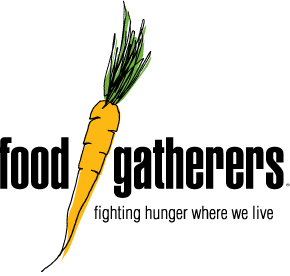Learn About Hunger
Hunger vs. Food Insecurity
What is hunger?
Hunger is the personal, physical sensation of discomfort from a lack of food. Hunger can also lead to a lack of concentration, irritability, and social and behavioral issues — particularly in children. Individuals who are food insecure may experience hunger.
What is food insecurity?
Food insecurity is the lack of reliable, consistent access to enough affordable, nutritious food for an active, healthy lifestyle. Hunger is related to food insecurity, but food insecurity refers to a lack of available financial resources for or access to food in a household. Food Gatherers often refers to hunger and food insecurity interchangeably but at its core, our mission focuses on alleviating food insecurity and its root causes.
Food Insecurity in Our Community
Food insecurity exists in every city, township, and zip code of Washtenaw County.
Feeding America has shared data with us from their most recent Map the Meal Gap study which reflects 2022 estimates of food insecurity. While food insecurity estimates are calculated from data that is a few years old, we have estimates of the percent and number of people experiencing food insecurity by zip code and census tract. We have mapped that data (click here) to illustrate the difference across the county.”
Food Insecurity in America
Millions of children and families living in America face hunger and food insecurity every day.
- The pandemic has had the greatest impact on families that were already experiencing food insecurity or one paycheck away from becoming food insecure.
- According to the USDA’s latest Household Food Insecurity in the United States report, 33.8 million people in the United States experienced food insecurity in 2021.
- Households with children are more likely to experience food insecurity.
- 19.8% of Black households reported food insecurity, while the national food insecurity rate was 10.2%.
- Every community in the country is home to families who face food insecurity, including rural and suburban communities.
- Many households that experience food insecurity do not qualify for federal nutrition programs and visit their local food banks and other food programs for extra support.
Source: Household Food Security in the United States in 2021, USDA
Hunger, Health, and Equity
Nutritious food plays an essential role in health, and a lack of sufficient food and the right type of food can lead to devastating health outcomes. People who are food insecure are disproportionately affected by diet-sensitive chronic diseases such as diabetes and high blood pressure. Being food insecure often means making tough choices between paying for food and paying for medicine and/or medical care.
Consistent access to affordable, healthy food is also influenced by factors like poverty and discrimination. As a result, food insecurity is also an issue of equity and has a disproportionate impact on low-income households, Black and Hispanic families, female-headed households, and families with children.
According to the U.S. Department of Agriculture, Black and Hispanic households have had higher annual rates of food insecurity compared to the national average among all households since 1995. In 2021, 19.8% of Black households reported food insecurity, while the national food insecurity rate was 10.2%.
To increase food security for everyone, we must actively incorporate equity into our responses. By examining the fundamental causes of food insecurity and health inequities, we can work to dismantle systemic racism, which is at the root of inequities in health, hunger, and economic opportunity.
Additional Resources
Looking for additional information on hunger? Click on the button below for a list of additional resources.
